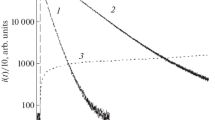Abstract
Protein oxidation, mediated by peroxyl radicals derived from 2,2′-azobis(2-amidinopropane) dihydrochloride is sided by a significant visible chemiluminescence (CL). The light emission shows a complex dependence with the protein concentration and with the incubation time that cannot be interpreted in terms of peroxyl radicals recombination (Russell's mechanism). In all the systems studied, the chemiluminescent behavior requires to consider the participation of several oxidation products as precursors of the excited states. These compounds lead to the formation of excited states by competing radical and nonradical mediated pathways. These intermediates (most probably hydroperoxide-like compounds) would arise from the oxidation of Trp and Tyr residues. This conclusion is based on the similarity of the time profile of the chemiluminescence observed in the oxidation of the free amino acids and the proteins, both in the presence of and absence of free-radical scavengers.
Similar content being viewed by others
REFERENCES
Aspée, A. and Lissi, E. A. (2000). Kinetics and mechanism of the chemiluminescence associated to the free radical mediated oxidation of amino acids. Luminescence 15, 273.
Aspée, A. and Lissi, E. A. (2001). Chemiluminescence associated to amino acid oxidation mediated by hypochlorous acid. Luminescence (in press).
Barnard, M. L., Gurdian, S., Diep., D., Ladd, M., and Turrens, J. F. (1993). Protein and amino acid oxidation is associated with increased chemiluminescence. Arch.Biochem.Biophys. 300, 651.
Fornier de Violet, P., Veyret, B., Vincendeau, P., and Caristan, A. (1984). Chemiluminescence induced by oxidation of tryptophan by singlet oxygen and by hypochlorous acid: Implications of the luminescence emitted in phagocytosis. Photochem.Photobiol. 39, 707.
Gursky, O., Badger, J., Li, Y., and Caspar, D. L. (1992). Conformational changes in cubic insulin crystals in the pH range 7–11. Biophys. J. 63, 1210.
Lee, J. and Seliger, H. H. (1970). Spectral characteristics of the excited states of the product of the chemiluminescence of luminol. Photochem. Photobiol. 11, 247.
Leonidas, D. D., Shapiro, R., Irons, L. I., Russo, N., and Acharya, K. R. (1997). Crystal structures of ribonuclease A complexes with 5´-diphosphoadenosine-3´-phosphate and 5´-diphosphoadenosine-2´-phosphate at 1.7 A resolution. Biochemistry 37, 5578.
Lissi, E. A., Cáceres, T., and Videla, L. A. (1988). Visible chemiluminescence from rat homogenated undergoing autoxidation. II. Kinetics of the luminescence decay. Free Rad.Biol.Med. 4, 93.
Lissi, E. A. and Clavero, N. (1990). Inactivation of lysozyme by alkylperoxyl radicals. Free.Rad.Res.Comms. 10, 177.
Lissi, E. A., Faure, M., and Clavero, N. (1991a). Effect of additives on the inactivation of lysozyme mediated by free radicals produced in the thermolysis of 2,28-azo-bis-(2-amidinopropane). Free Rad. Res.Comms 14, 373.
Lissi,. A., Salim-Hanna, M., Fauré, R., and Videla, L. A. (1991b). 2,28-azo-bis-amidinopropane as a radical source for lipid peroxidation and enzyme inactivation studies. Xenobiotica 21, 995.
Lissi, E. A., Pizarro, M., Aspée, A., and Romay, C. H. (2000). Kinetics of phycocyanine bilin groups destruction by peroxyl radicals. Free Rad.Biol.Med. 28, 1051.
Müller, A., Cadenas, E., Graf, P., and Sies, H. (1984). A novel biologically active seleno-organic compound-I. Biochem.Pharmacol. 33, 3235.
Pollet, E., Martínez, J. A., Metha, B., Watts, B. P., and Turrens, J. F. (1998). Role of tryptophan oxidation in peroxynitrite-dependent protein chemiluminescence. Arch.Biochem.Biophys. 349, 74.
Rao, S. T. and Sunderalingam, M. Studies of monoclinic hen egg white lysozyme. IV. X-ray refinement al 1.8 angstrom resolution and a comparison of the variable regions in the polymorphic forms. (in press).
Russell, G. A. (1957). Deuterio isotope effect in the autoxidation of aralkyl hydrocarbons. Mechanism of the interaction of peroxyl radicals. J.Am.Chem.Soc. 79, 3871.
Stevani, C. V., Silva, S. M., and Baader, W. J. (2000). Studies on the mechanism excitation step in peroxalate chemiluminescence. Eur. J.Org.Chem. 24, 4037.
Videla, L. A., Villena, M. I., Donoso, G., de la Fuente, J., and Lissi, E. (1984). Visible chemiluminescence induced by t-butyl hydroperoxide in red blood cell suspensions. Biochem.International 8, 821.
Author information
Authors and Affiliations
Rights and permissions
About this article
Cite this article
Aspée, A., Lissi, E.A. Kinetics of the Chemiluminescence Associated to the Reaction Between Peroxyl Radicals and Proteins. J Protein Chem 20, 479–485 (2001). https://doi.org/10.1023/A:1012554429450
Published:
Issue Date:
DOI: https://doi.org/10.1023/A:1012554429450




